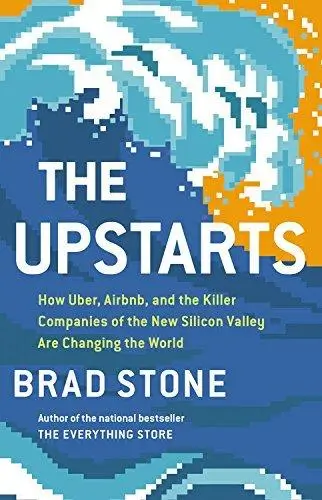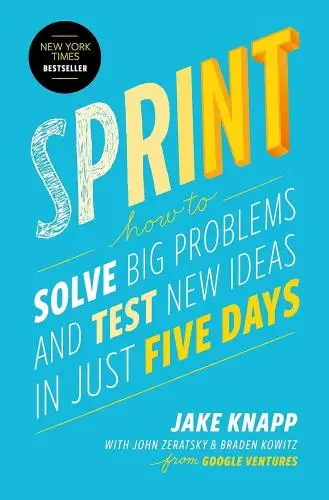Sprint
How to Solve Big Problems and Test New Ideas in Just Five Days
What's it about?
Sprint by Jake Knapp offers a revolutionary approach to problem-solving for businesses. This book guides you through a unique five-day process, designed to help teams answer critical business questions through designing, prototyping, and testing ideas with customers. It's a fast-track to innovation, cutting through endless debates and uncertainties. Perfect for startups and large organizations alike, Sprint equips you with a concrete strategy to tackle big challenges, one week at a time.
About the Author
Jake Knapp is the mastermind behind the revolutionary "Sprint," a book that redefines problem-solving in the business world. With his background at Google Ventures, he crafts a unique, fast-paced approach to innovation, focusing on design sprints to transform how companies create and improve products. Knapp's writing is engaging and accessible, offering readers a front-row seat to the strategies that have propelled startups to success. His work is a blend of insightful anecdotes and actionable advice, making complex concepts digestible and exciting for professionals across industries.
10 Key Ideas of Sprint
Set the Stage with a Clear Goal and a Diverse Team
Begin by establishing a clear, achievable goal for the sprint to ensure everyone is aligned and motivated.
Assemble a diverse team with different skill sets and perspectives to tackle the problem from various angles.
This diversity fosters creativity and innovation, allowing for a comprehensive approach to problem-solving.
Learn DeeperDefine Your Goal Clearly: Start by articulating what you want to achieve with your sprint. Make it specific, measurable, achievable, relevant, and time-bound (SMART). This clarity will serve as a north star, keeping the team focused and aligned throughout the process.
Select Your Team Wisely: Look beyond the usual suspects. Include members from different departments or areas of expertise. Think about adding someone from customer service, marketing, or even finance, depending on the problem you're solving. This mix will enrich the perspectives and solutions proposed.
Foster Open Communication: Encourage every team member to voice their ideas and concerns without fear of judgment. Establish ground rules that promote respect and openness from the get-go. This environment will enable the diverse team to collaborate effectively and innovate.
Schedule Regular Check-ins: Set up brief daily meetings to ensure the team stays on track towards the goal. Use these check-ins to address any roadblocks and adjust plans as necessary. Keeping everyone in the loop will maintain momentum and motivation.
- Example
If your goal is to improve the user experience on your e-commerce website, you might include a web developer, a UX designer, a customer service representative, and a product manager in your sprint team. The clear goal could be to decrease shopping cart abandonment by 20% within three months.
- Example
For a sprint aimed at reducing operational costs, assemble a team comprising an operations manager, a finance analyst, a frontline employee, and a technology specialist. The goal might be to identify and implement cost-saving measures that reduce operational expenses by 15% in one quarter.
Map Out the Problem to Understand the Challenge Fully
To create a visual map outlining the user journey, key actions, and touchpoints, follow these steps:
Define the User Journey Stages
Identify the main stages of the user journey related to the problem.
Common stages include:- Awareness
- Consideration
- Decision
- Retention
- Advocacy
Identify Key Actions
For each stage, list the key actions users take.
Examples might include:- Researching options during the Awareness stage
- Comparing products in the Consideration stage
- Making a purchase in the Decision stage
- Engaging with customer support in the Retention stage
Map Touchpoints
Determine the touchpoints where users interact with your product or service.
These can include:- Website visits
- Social media interactions
- Email communications
- Customer service calls
Visual Representation
Create a visual representation of the user journey.
Use flowcharts, diagrams, or infographics to illustrate the stages, actions, and touchpoints.
Ensure that the map is clear and easy to follow.Identify Critical Areas for Intervention
Analyze the map to pinpoint areas where users may face challenges or drop off.
Highlight these areas for further investigation and potential solutions.Collaborate and Share
Share the visual map with the team to foster a shared understanding of the user journey.
Encourage feedback and discussion to refine the map and address any gaps.
By following this process, the team can gain valuable insights into the user experience, ensuring a focused approach to solving the identified problem.
Learn DeeperIdentify Your End User: Start by clearly defining who your end user is. This could be a customer, a client, or even an internal team member. Understanding who you're solving the problem for is crucial.
Break Down the User Journey: Map out the steps your user takes from the moment they encounter the problem to the final solution. Include every interaction and touchpoint they have with your product or service.
Highlight Pain Points and Opportunities: As you map the journey, mark areas where users experience frustration, confusion, or dissatisfaction. These are your key areas for improvement.
Gather Your Team for a Mapping Session: Bring together team members from different departments (e.g., design, marketing, customer service) to contribute diverse perspectives on the problem.
Visualize the Map: Use a whiteboard, sticky notes, or digital tools to create a visual representation of the user journey. This makes it easier for everyone to grasp the problem and contribute ideas.
Regularly Update the Map: As you learn more about your users and make changes to your product or service, update the map to reflect new insights and improvements.
- Example
A mobile app development team maps out the user journey for their shopping app, identifying that users get frustrated with the complicated checkout process. They then focus on simplifying this step in the app.
- Example
A customer service team at an online retailer creates a map of the customer support journey, highlighting long wait times as a major pain point. They use this insight to implement a callback feature, improving customer satisfaction.
Select a Target: Focus on a Manageable Chunk of the Problem
Identify a specific aspect of the problem to focus on during the sprint.
Trying to tackle everything at once can be overwhelming and unproductive.
By narrowing the focus, the team can dive deep into developing effective solutions for a critical part of the overall challenge.
Learn DeeperIdentify the Core Problem: Start by clearly defining the problem you're aiming to solve. Break it down into smaller, manageable parts and focus on the one that seems most critical or impactful.
Set Clear Objectives: Once you've identified your target, set specific, measurable goals for what success looks like. This will help keep the team focused and motivated.
Gather a Focused Team: Assemble a small, dedicated team with the right skills to tackle the chosen problem. Ensure everyone understands the target and their role in reaching it.
Develop a Plan: Outline a step-by-step plan for addressing the target. This should include key milestones, tasks, and deadlines to keep the team on track.
Review and Iterate: At the end of the sprint, review the outcomes against your objectives. Learn from what worked and what didn't, and use these insights to refine your approach for the next sprint.
- Example
A software development team is overwhelmed by the number of features requested for a new app. They decide to focus their sprint on developing a single, critical feature: user authentication. They break down the task into smaller steps, assign roles, and set a two-week deadline to complete a working prototype.
- Example
A marketing team is tasked with increasing website traffic but has limited resources. They choose to concentrate their efforts on improving SEO for their top-performing articles. The team identifies key keywords, updates content, and monitors page rankings over a month, adjusting their strategy based on the results.
Generate Solutions through Individual Sketching
Encourage each team member to sketch out their ideas independently.
This approach leverages the diverse perspectives within the team and avoids groupthink.
It allows for a wide range of solutions to emerge, which can then be refined and combined into a cohesive strategy.
Learn DeeperSchedule Individual Sketching Sessions: Set aside dedicated time for each team member to independently sketch out their ideas. This could be during a specific hour of the day or a designated day of the week, ensuring there's a quiet, uninterrupted space for creativity.
Use a Common Template for Sketches: To streamline the process and make it easier to compare ideas later, provide a simple template or framework for sketches. This could include sections for the problem statement, proposed solution, key features, and potential challenges.
Organize a Sharing Session: After the individual sketching, organize a session where everyone presents their sketches. Encourage an environment of constructive feedback, where the focus is on building upon ideas rather than critiquing them.
Combine and Refine Ideas: Post-sharing session, work as a team to identify common themes or particularly innovative solutions. Use these insights to combine sketches into a more cohesive strategy that incorporates the best aspects of each.
- Example
In a mobile app development team, each member sketches out their vision for a new feature that aims to improve user engagement. They use a template that asks for a brief description, how it fits into the user journey, and a rough wireframe. Afterward, they come together to merge their ideas into a comprehensive feature design.
- Example
A marketing team working on a campaign for a new product dedicates an afternoon to individual sketching. Each member focuses on different aspects like social media strategy, email marketing, and in-store promotions. They then present their ideas, finding overlaps and unique approaches that can be combined into a multi-channel campaign.
Decide on the Best Solution with a Structured Decision-making Process
Use a systematic approach to review and select the most promising solution from the sketches.
This could involve voting, debate, or a decision matrix.
A structured decision-making process ensures that the selection is objective and based on the solution's potential impact and feasibility.
Learn DeeperGather Your Team for a Decision Meeting: Invite all key stakeholders and team members who contributed ideas or have a stake in the outcome. This ensures diverse perspectives and buy-in from the start.
Use Dot Voting for Initial Filtering: Give everyone a set number of dot stickers (or virtual equivalents) to vote on their favorite ideas or sketches. This democratic approach helps surface the most popular options quickly.
Facilitate a Structured Debate: Allow time for proponents of the top-voted ideas to present their case, followed by a structured discussion. This helps clarify the strengths and weaknesses of each option.
Implement a Decision Matrix: Create a matrix that evaluates each option against criteria important to your project, such as feasibility, impact, and resource requirements. Assign scores to objectively compare the options.
Make the Final Decision: Based on the outcomes of the voting, debate, and decision matrix, make an informed final choice. Remember, the goal is to select the solution with the highest potential for success, not necessarily the most popular one.
- Example
A software development team is trying to decide which feature to build next. They gather all the feature requests and ideas, use dot voting to narrow down the options, then discuss the pros and cons of each in a meeting before using a decision matrix to evaluate each idea based on estimated development time, potential user impact, and alignment with company goals.
- Example
A marketing team is selecting a concept for their next campaign. They start with a wide range of creative sketches and ideas. Through dot voting, they identify the top three. They then hold a debate to discuss the merits and challenges of each, considering factors like budget, timeline, and expected reach. Finally, they score each concept against these criteria in a decision matrix to choose the most effective campaign idea.
Deeper knowledge. Personal growth. Unlocked.
Unlock this book's key ideas and 15M+ more. Learn with quick, impactful summaries.
Read Full SummarySign up and read for free!
Sprint Summary: Common Questions
Experience Personalized Book Summaries, Today!
Discover a new way to gain knowledge, and save time.
Sign up for our 7-day trial now.
No Credit Card Needed

Similar Books

$100M Offers
Alex Hormozi
Principles of Marketing, Global Edition
Gary Armstrong
The 100 Best Business Books of All Time
Jack Covert
Playing to Win
A.G. Lafley
Productize
Eisha Armstrong
Start Your Own Pet-Sitting Business and More
Entrepreneur Press
The 22 Immutable Laws of Marketing
Al Ries
The Upstarts
Brad Stone
Lean Analytics
Alistair Croll
Built to Sell
John WarrillowTrending Summaries

Peak
Anders Ericsson
Never Split the Difference
Chris Voss
Smart Brevity
Jim VandeHei
The Psychology of Money
Morgan Housel
The First 90 Days
Michael D. Watkins
Atomic Habits
James Clear
Thinking, Fast and Slow
Daniel Kahneman
The Body Keeps the Score
Bessel van der Kolk M.D.
The Power of Regret
Daniel H. Pink
The Compound Effect
Darren HardyNew Books

The Art of Spending Money
Morgan Housel
$100M Offers
Alex Hormozi
A Candle for Kiri
Edna Mae Holm
Principles of Marketing, Global Edition
Gary Armstrong
Serpent Rising: The Kundalini Compendium
Neven Paar
Feeling Is the Secret
Neville Goddard
The 100 Best Business Books of All Time
Jack Covert
My Oxford Year
Julia Whelan
Trading in the Zone
Mark Douglas

